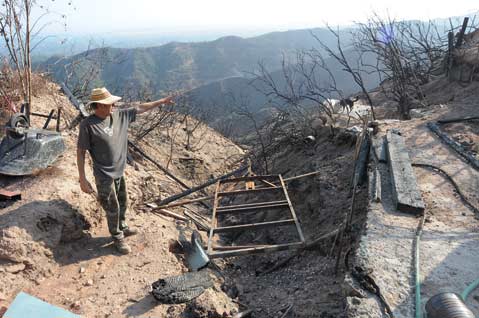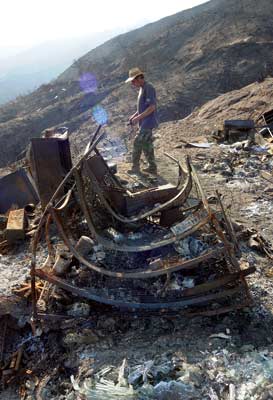Burned by the Gap
Not Everyone Escaped Goleta Blaze Unscathed

Much of the community breathed a sigh of relief when the Gap Fire entered its final days, having only claimed a few outbuildings and some lemon and avocado orchards. Not everybody was fortunate, however, as residents of the county’s wilderness-adjacent communities can attest.
Melted Metal
Sifting through the debris left behind after the Gap Fire swept across his property, Allen Murray, 52, picked up a lump of aluminum, once part of a power tool he owned. “I find these metallic tears to be poignant,” he said, looking around at the charred remains of most of his belongings. Murray, who lives in the wilderness west of Old San Marcos Road with girlfriend Stephanie Wycott, 37, lost everything but his truck and some animals. All that remains of their trailer home is the steel ladder frame that the wheels were attached to.
The couple lived in a cabin on Forest Service land for several years, but after last year’s Zaca Fire, the Forest Service cancelled leases on cabins off Paradise Road, forcing Murray and Wycott to seek lodging elsewhere. For the past two years, Murray-a carpenter who spent 20 years building sets in Hollywood-has been helping David Sampanis improve roads and buildings on property off Old San Marcos Road. A liquidator who spends much of his time at estate sales around Los Angeles, Sampanis aims to plant a sustainable agricultural operation on the property. Since Murray was already working on his land and tending a flock of goats-many of which were killed last year by mountain lions displaced by the Zaca Fire-Sampanis agreed to let Murray and Wycott live there.
They had barely moved into their new home on the other side of the mountain on June 31-the day before the fire started. During the next few days, they watched helplessly as the fire moved closer to their popup tent trailer. On July 2, Murray rode a small dirt bike to a ridge where he could better observe it. The bike broke down on the way to the fire’s edge. “I knew I didn’t have much time, but the bike wouldn’t start,” said Murray, explaining that he then ran back to the camp with just enough time for himself and Wycott to load their six goats, seven dogs, two cats, and llama into a trailer and into his truck. A pig the couple owned refused to get into the trailer, so they had to leave her behind. Badly burned, the pig lived for three days. “I’m just heartbroken about my pig,” Murray said. “I sprayed her with aloe and took care of her [when we came back], but she didn’t make it. At least she knew I didn’t abandon her.”

Murray and Wycott are hopeful that Sampanis’s insurance will cover some of their loss. “It’s not the stuff. We were lucky to get out of here with our skin,” Murray said. He and Wycott are preparing for rain-caused mudslides on the ash- and silt-covered slopes denuded by the fire by shoring up parts of the dirt entrance road that they think will be problem areas. “Fire is nature’s way of cleaning things out,” Murray said. “This is kind of a blessing, because it gives us a chance to start with a clean slate.” They noted that the Red Cross has helped them weather this rough patch. Most of Murray’s carpentry tools are now melted slag heaps drizzling the dirt hillsides next to their camp. “We don’t see ourselves as victims at all,” said Wycott as she prepared a pasta dinner on a propane stove. Setting out solar lights as the sun went down, she said they were already adapting to the changes that have taken place. “As long as I’m in good enough health to put on a pair of boots, I’m going to keep going for it,” Murray said.
The couple now lives in a small studio Murray built for Sampanis, which he proudly said had been deemed up to code by the county’s building inspector. Although the landscape in their little valley looks post-apocalyptic, the scarlet blossoms of sumac plants are already poking out of the black soil next to charred lumber and personal belongings, a sign that these two said they take as a hopeful one.
Gardens of Ash
Much planning and care went into Karen Flagg and Don Hartley’s vision of large-scale sustainability for their Puma Canyon ranch in northern Goleta. At the beginning of July, their dreams were blossoming, with 22 acres of avocados scheduled to be harvested the next week. But early on July 4, the Gap Fire hit the ranch from four different directions. On the night their property was burning, Flagg and Hartley drove up the road, but it was too hot to get in. When they were able to return the following day it was a surreal experience, they said. Around the structures, everything was burned and hotspots were still smoking. “It was just ash and the smell of burnt,” Flagg said. “It’s just very unbelievable. Such a magnificent force that just comes through and goes where it wants to go.”
And after the flames had moved on, Flagg and Hartley were left to assess the remains of their ranch. “It’s been a very trying experience, and now we have all the challenges of rebuilding. It has put our plans and our programs behind schedule-if it’s even feasible to rebuild; we don’t even know if it’s possible. Now we’ll just have to wait and see,” said Flagg.
The loss cannot only be measured in avocados and acreage, but in the tremendous setback it brought to Flagg and Hartley’s plans for a progressive farming utopia that integrated “finger patches” of native habitat, making homes for native pollinators within non-native crops. Careful design, planning, and seed collection went into the project to ensure that native species with local genotypes were planted and that native pollinators had the food and shelter needed to thrive in the midst of the orchards.
While Flagg and Hartley are continuing the process of cleaning up their ranch, they are staying optimistic by focusing their energy on the nonprofit ecological education organization they cofounded, Growing Solutions. Ten years ago, Flagg and Hartley founded Growing Solutions as an avenue for ecological education through hands-on projects. The organization’s mission is to restore degraded property to a functioning ecosystem with an emphasis on using native species and local genotypes so that DNA remains in a specific geographical area. Growing Solutions has nurseries and educational programs throughout the region. The environmental ideals that Flagg and Hartley promote through Growing Solutions had been incorporated into their ranch with the hope of involving students in ranch operations through educational programs.
Even though this dream has undergone a major setback, they remain hopeful, especially with the excitement of Jack Johnson’s upcoming All at Once concert series, to which Growing Solutions was invited. Through the event, Johnson is raising awareness and matching donations made to environmental organizations. Although funds raised during this event are not directly related to restoring Flagg and Hartley’s ranch, it is a bit of excitement in the midst of a whole lot of ash.



